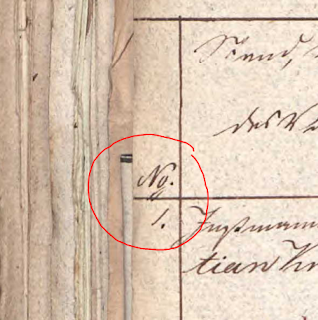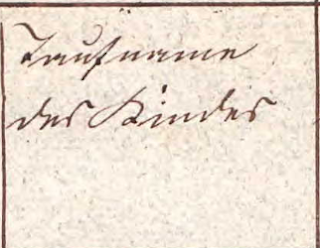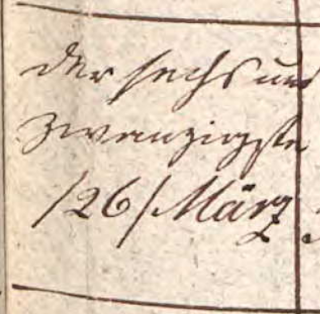 |
| The Birth Record of Carl Friedrich Warner in Pomerania (entry number 2) |
Before I begin, it's also worth noting that this book is what's called a "Kirkenbuchduplikate" in German, or a "Duplicate" or "Transcript" in English. That means that the local pastor copied down the vital records for each year and sent them off to the parish. So instead of having a single book for just births, one for just deaths, etc., all three are included in a single book grouped by year.
Specifically, I grabbed this record from ancestry.com, here is the original citation information:
Greifswald State Archives
Ancestry.com. Pomerania, Germany, Parish Register Transcripts, 1544-1883 [database on-line]. Provo, UT, USA: Ancestry.com Operations, Inc., 2015.
Original Data: Kirkenbuchduplikate Pommern. Digital images. Landesamt für Kultur und Denkmalpflege, Landesarchiv Greifswald. Greifswald, Deutschland.
The Header
 |
| The Document Header |
This document contains a fairly standard header. The information contained includes the type of vital events shown and the year. The (near) exact transcription is "Geboren und Getauften im Jahr 1843". Geboren translates to births, Getauften to baptisms, and im Jahr to in the year. It, therefore, says "Births and baptisms in the year 1843".
 |
| The document's page number, 238 |
Sometimes there will also be a page number, but not always. In this document, the page number is penciled in at the upper right-hand corner. We can see that this is page 238.
The Entry Number
 |
| Entry Number circled header |
This is often the first field you see in a document if it is there at all. In this case, it is identified by 2 letters. They appear to me to be 'No.', however, they are more likely 'Nu.' as the German word for number is nummer. Ultimately, it doesn't really matter which it is, just that it is the entry number.
 |
| The entry number (2) for Carl Friedrich Warner circled |
Most of the time the entry number is the number of the birth during the year as a whole. On occasion, it is the number the birth appears on the page.
The Parents' Information
 |
| Parents' information header |
Here we see the box containing the parents' information. Usually, these boxes contain the occupation, first name, and last name of each parent.
The first part of the sentence (circled in red) says "Stand, Vor und Zunamen". Translated, this means "Occupation, first, and last name". Occasionally you will also see the word 'wohnort' here, meaning their place of residence.
The words circled in blue and black are "des vaters" and "der mutter", meaning "the father" and "the mother" respectively.
 |
| Information about the parents of Carl Warner |
Pictured above are the actual contents of the Parents section for Carl Warner. Everything that is not circled is part of the name of each of his parents. On the left, we see that his father's name is Michael Friedrich Warner while his mother's name is Johanna Eleonore Brandenburg.
Circled in red is the occupation of his father, an Instmann (a type of farmer). Occupations in German records nearly always come immediately before the person's name. Notice that his mother does not have an occupation before her name. This will not always be the case, on occasion you may see the word "Ehefrau", or 'housewife as the occupation. If this were a marriage record then the occupation field may contain words such as "Jungfrau" or "Jungfer", both words used to describe unmarried women.
Circled in green is what appears to be an equal sign. This is a common symbol used in German records. Just like how you use a dash in English, if you start writing a word in German and don't have enough space to finish it, you can use the equal sign and continue writing on the next line. Its usually easy and self-explanatory to identify it, but sometimes when the writing is squashed in especially tight you will only notice it if you are looking for it.
Circled in blue is the abbreviation 'geb.' short for geboren. In German, its the equivalent of née, meaning that Brandenburg is her maiden name.
The Child's Name
 |
| The section header for the child's name section |
This section usually only gives a single piece of information, that being the birth name of the child. The exact transcription of what is written is "Taufname der kinder". A taufname is a childs first name. The first part of the word "tauf" is similar to the word for baptism because the name was often given to the child at their baptism. The full translation is "The first name of the child".
 |
| Carl Friedrich's first name |
Here is Carl Friedrich's first name within the document.
The Birth Date
 |
| The section header for the child's birth date |
Usually the birth date section gives you two main pieces of information: The date and time of the child's birth. The transcription of this particular header is: "Tag und Stunde der Geburt", which means the day and hour of birth.
 |
| Carl Friedrich's birth information |
Now the actual contents of this section are rather verbose. Breaking it down:
- Circled in red is the year of the birth
- Circled in dark blue is the date Carl was born written out fully. In this case, he was born on the 13th, which in German is dreizehnte. Note the tiny equal sign at the end of the word on the first line connecting the 'dreizehn' on the first line to the 'te' on the second line.
- Circled in light blue is the date Carl was born on written in numerical form as '13'. I usually see numbers separated from the other parts of the texts using slashes as shown, so they are usually fairly easy to pick out
- Circled in green is the month he was born in, which was 'März' or, in English, 'March'
- Circled in black is the part of the day Carl was born in. There are a limited number of words you will see in this section. Usually, you see either "Vormittags" or "Morgens", meaning the child was born in the morning, or "Nachmittags", meaning the child was born in the afternoon. In this case we see Carl was born in the morning, as the word "Morgens" is used.
- Circled in yellow is the specific time Carl was born. It reads: "/1/ uhr" meaning "one o'clock"
The Legitimacy of the Child
 |
| The section header for the legitimacy of the child |
There is only one piece of information you can get from this section, whether the child was legitimate or illegitimate. It's usually easy to tell this section apart from the other ones because there are so many h characters inside.
 |
| Two typical examples of the letter h in Kurrentschrift (source) |
The transcription of the section header is "ehelich oder unehelich" meaning "legitimate or illegitimate"
 |
| Legitimacy of Carl |
If we look at Carl's statement of legitimacy, we see that it says 'ehelich' meaning he was legitimate. In the event you can't tell the difference between the words 'ehelich' and 'unehelich', simply look at the fields of everyone else's children. Most children will be listed as legitimate, so its safe to say that if the word in the box for your family member looks like the word in everyone else's, they were probably legitimate. If they are the odd one out then they are likely illegitimate.
The Baptism Date
 |
| The section header for the child's baptism date |
This field contains essentially the same information and follows nearly the same format as the birth field minus the exact hour of baptism. The exact transcription of this field header is "Tauftag" or baptism day.
 |
| Carl's Baptism date |
Godparents
 |
| The Godparent's header |
This is usually one of the most saturated sections, containing a huge amount of useful information as those selected to be godparents were often esteemed members of the community, neighbors, close friends, or family.
The transcription of the header is "Stand, Vor, und Zunamen, auch Aufenthaltsort der Taufzeugen" meaning "The occupation, first, and last name, as well as the residence place of the godparents."
Aufenthaltsort is also sometimes replaced with one of its synonyms: 'Wohnort' as both mean place of residence.
 |
| Carl's Godparents |
Pictured above are the contents of the field reserved for Carl's godparents. I found it somewhat interesting that every single one of his godparents were also named Carl (with the exception of the female godparent, but still her husband was named Carl as well. If they all were present at the baptism, as was custom, I can only imagine the confusion whenever one of the Carls was addressed. Just like many other sections, the godparent list follows a fairly standard format:
- Circled in red are the occupations of each of the 3 godparents
- Circled in blue is the occupation of the husband of the female godparent
- Circled in black is the residence location of one of the godparents. The other two live in the same location Carl was born, as evidenced by the lack of an alternate location at the end of their lines. Occasionally instead of leaving the residence location blank for those residing in the same place, the word "hier", "allhier", or another word meaning "in this place" will be written.
The full transcription of this piece of the record is as follows:
- Instmann Carl Henning
- Schneider Carl Eggert in Moderow
- Ehefrau das instmannes Carl Klemm
Translated this means:
- The farmer Carl Henning
- The tailor Carl Eggert living in Moderow
- The housewife of the farmer Carl Klemm
Additional Remarks
 |
| The section header reserved for additional remarks |
I do have a birth certificate where the child's last name was his Mother's last name. There is no father listed. I wish there were a way to find out who he was. Your post was extremely helpful. Thank You
ReplyDeleteI have searched for something like this for a very long time.....this is so helpful! Thank you so much! I hope you consider doing more like this!
ReplyDeleteThanks for sharing us. german transcription
ReplyDeleteI am definitely enjoying your website. You definitely have some great insight and great stories. german transcription services
ReplyDeleteThank you so much, very very helpful.
ReplyDelete